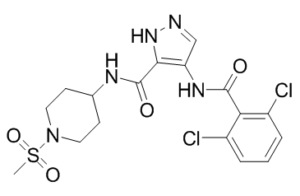NVP-LCQ195 (formerly also known as AT9311; AT-9311; LCQ195; LCQ-195) is a novel and potent small molecule heterocyclic inhibitor of cyclin-dependent kinases CDK1, CDK2, CDK3 and CDK5 with IC50 of 1-42 nM. Even at sub-μmol/l concentrations, LCQ195 caused MM cells to enter a cell cycle arrest and ultimately undergo apoptosis. It also preserved non-cancerous cells and eliminated the shield that the bone marrow milieu's stroma or cytokines provided for MM cells. Given the higher rates of tumor cell proliferation in advanced MM compared to early stages, cell cycle regulators, such as cyclin-dependent kinases (CDKs), are attractive targets for multiple myeloma (MM) therapy.
Physicochemical Properties
| Molecular Formula | C17H19CL2N5O4S |
| Molecular Weight | 460.3349 |
| Exact Mass | 459.053 |
| Elemental Analysis | C, 44.36; H, 4.16; Cl, 15.40; N, 15.21; O, 13.90; S, 6.96 |
| CAS # | 902156-99-4 |
| Related CAS # | 902156-99-4 |
| PubChem CID | 11655534 |
| Appearance | White to off-white solid powder |
| LogP | 3.916 |
| Hydrogen Bond Donor Count | 3 |
| Hydrogen Bond Acceptor Count | 6 |
| Rotatable Bond Count | 5 |
| Heavy Atom Count | 29 |
| Complexity | 701 |
| Defined Atom Stereocenter Count | 0 |
| SMILES | O=C(C1C(Cl)=CC=CC=1Cl)NC1C(C(NC2CCN(S(C)(=O)=O)CC2)=O)=NNC=1 |
| InChi Key | CCUXEBOOTMDSAM-UHFFFAOYSA-N |
| InChi Code | InChI=1S/C17H19Cl2N5O4S/c1-29(27,28)24-7-5-10(6-8-24)21-17(26)15-13(9-20-23-15)22-16(25)14-11(18)3-2-4-12(14)19/h2-4,9-10H,5-8H2,1H3,(H,20,23)(H,21,26)(H,22,25) |
| Chemical Name | 4-[(2,6-dichlorobenzoyl)amino]-N-(1-methylsulfonylpiperidin-4-yl)-1H-pyrazole-5-carboxamide |
| Synonyms | NVP-LCQ-195; NVP-LCQ195; NVP-LCQ 195; LCQ 195; LCQ-195; LCQ195; AT9311; AT-9311; AT 9311 |
| HS Tariff Code | 2934.99.9001 |
| Storage |
Powder-20°C 3 years 4°C 2 years In solvent -80°C 6 months -20°C 1 month |
| Shipping Condition | Room temperature (This product is stable at ambient temperature for a few days during ordinary shipping and time spent in Customs) |
Biological Activity
| Targets | Cdk5/p25 (IC50 = 1 nM); CDK5/p35 (IC50 = 1 nM); Cdk1/cyclin B (IC50 = 2 nM); cdk2/cyclin A (IC50 = 2 nM); CDK2/cyclinE (IC50 = 5 nM); CDK9/cyclinT1 (IC50 = 15 nM); CDK3/Cyclin E (IC50 = 42 nM); cdk6/cyclin D3 (IC50 = 187 nM); CDK7/Cyclin H/MAT1 (IC50 = 3564 nM) |
| ln Vitro |
LCQ195 potently inhibits CDK 1, 2 and 5 activity and also modestly targets CDK3 and 9. These distinct patterns of inhibition of CDKs correlate with different patterns of activity against MM cells. [1] EC50 values with seliciclib for most MM cell lines are >10 μM compared to ~1 μM or lower for similar cell lines treated with LCQ195. [1] Signaling through the Rb pathway is reduced by LCQ195, but remains largely unaffected by flavopiridol. In addition, the anti-MM activity of LCQ195 does not involve the release of cytochrome c and is not suppressed by the over-expression of bcl-2. LCQ195, therefore, appears to operate through mitochondrial-independent mechanisms of apoptosis.[1] |
| Enzyme Assay | Kinases involved in cell cycle were screened using the Invitrogen Z’-LYTE™ technology. Selected kinases were in the presence of 500 nM of LCQ195 (in 1% DMSO) and 100 μM ATP.[1] |
| Cell Assay |
The minimum exposure of MM cells to LCQ195 that is required to commit them to death was evaluated by incubating cells in 24-well plates with LCQ195 (2 μM) for 1-24 hrs.[1] The MM cell line MM.1S was treated with 2 μM LCQ195 for 0-48 hrs. [1] MM.1S cells were treated with 2 μM LCQ195 or with DMSO as a control for 2, 4, 8, 16, and 24 hrs; total RNA was then extracted and purified, cDNA synthesized and cRNA labeled prior to hybridization to the HT-U133 A and B Arrays. [1] |
| References |
[1]. Molecular and cellular effects of multi-targeted cyclin-dependent kinase inhibition in myeloma: biological and clinical implications. Br J Haematol. 2011 Feb;152(4):420-32. |
Solubility Data
| Solubility (In Vitro) | DMSO: 66.7~92 mg/mL (144.8~199.9 mM) |
| Solubility (In Vivo) |
Solubility in Formulation 1: ≥ 2.5 mg/mL (5.43 mM) (saturation unknown) in 10% DMSO + 40% PEG300 + 5% Tween80 + 45% Saline (add these co-solvents sequentially from left to right, and one by one), clear solution. For example, if 1 mL of working solution is to be prepared, you can add 100 μL of 25.0 mg/mL clear DMSO stock solution to 400 μL PEG300 and mix evenly; then add 50 μL Tween-80 to the above solution and mix evenly; then add 450 μL normal saline to adjust the volume to 1 mL. Preparation of saline: Dissolve 0.9 g of sodium chloride in 100 mL ddH₂ O to obtain a clear solution. Solubility in Formulation 2: ≥ 2.5 mg/mL (5.43 mM) (saturation unknown) in 10% DMSO + 90% Corn Oil (add these co-solvents sequentially from left to right, and one by one), clear solution. For example, if 1 mL of working solution is to be prepared, you can add 100 μL of 25.0 mg/mL clear DMSO stock solution to 900 μL of corn oil and mix evenly. (Please use freshly prepared in vivo formulations for optimal results.) |
| Preparing Stock Solutions | 1 mg | 5 mg | 10 mg | |
| 1 mM | 2.1724 mL | 10.8618 mL | 21.7235 mL | |
| 5 mM | 0.4345 mL | 2.1724 mL | 4.3447 mL | |
| 10 mM | 0.2172 mL | 1.0862 mL | 2.1724 mL |
